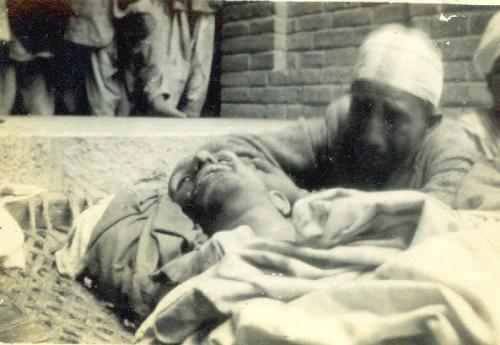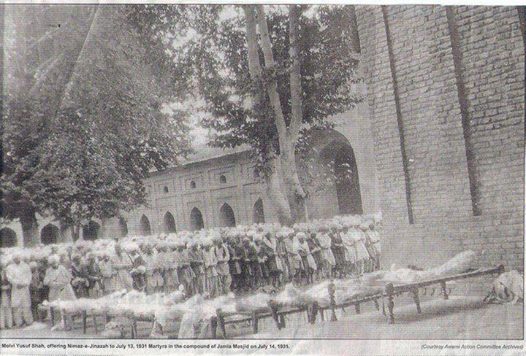“The dead bodies were scattered all over the street of Lal Chowk. Later a well-known person, Wali deen, with the help of others brought the dead bodies to Masjid Shah. The injured were helped by the known doctors, Ms Gomery and Ms Coverder from the Missionary hospital.”
By Insh’aa Bint Bashir

Islamabad, September 23, 1931
People were gradually pouring on streets. Hundreds of them were about to rally against the bloodbath. The news of July 13, 1931 episode that saw 21 lives being butchered by Dogra forces outside Srinagar’s Central Jail had kept the town on toes.
But shortly, the peaceful protest was painted red, bloody red! The trigger-happy Dogra forces were instructed to hound up the angry horde. Barrage of bullets soon spread mayhem in the town. People later realised that it was a trap laid down by Dogra administration to devour innocent lives. But, sadly, those shrieks of solidarity from south couldn’t make it to banner headlines.
Almost 84 years later, I learned about that gory incident occurred in my hometown, Islamabad. But before the dawn of Islamabad’s D-day, attempts were being made to disturb the communal harmony of the place.
The year 1924 was quite eventful in the history of Islamabad. Clashes had broken out between two communities in the town. These clashes took a heavy toll on the locals. It was a deliberate attack on the secular fabric of our society. Ours was the close-knit society well before India’s founding father saw a “ray of hope” in Kashmir.
During that time, Hindus were mostly residing from Islamabad’s Ashmuqam to Khanabal area. And many were dispersed over other parts of the town. Both communities were living in absolute harmony before some Hindus hatched up a mischievous plot to create disparity.
On June 2, 1924, Musalmaans of Islamabad thought of building a Chabutra (pigeon tower) around a Chinar tree at Sherbagh. They wanted to use it for offering prayers.
“As the news spread in the town,” my grandfather told me, while recollecting his memory in tits and bits, “many people came with their holdings. Some offered saved money for the cause. Others decided to sell a piece of land. And some… Every Muslim was so happy about this decision. Men and women assembled and discussed a lot about that sacred place.”

At that time, there was no transport. It was difficult for them to go Srinagar and bring a truckload of stones for the building. So they decided to fetch stones from the hill close to Sherbagh.
But to their dismay, some people from Hindu community informed Maharaja Pratap Singh, the then Dogra ruler of Kashmir about the Chabutra. It is said that those people requested the monarch: “Don’t grant permission to the Muslim community. They are devising a strategy against Hindus.”
“But this was a baseless and fabricated statement on their part,” my grandfather told me. “As a matter of fact, Chabutra had simply unnerved them!”
However, the Dogra king was too convinced with the version fed by Hindus. He sent one of his officials on the fact-finding mission in Islamabad on June 27, 1924. And soon the emissary gave his verdict: Muslims better forget about Chabutra!
A stern Dogra decree that followed barred Muslims from building any such structure in future.
The decision disgusted the Muslim community of Islamabad. They discussed, deliberated and decided to meet Maharaja. A Muslim delegation shortly left to meet Maharaja with a hope to request him to reconsider the decision and revoke the decree. But the meeting was turned down by Dogra officials.
As a result, the Chabutra hit the roadblock.
By September 23, 1925, Maharaja Pratap Singh died. And the throne was ascended by Maharaja Hari Singh. The new monarch set off celebrations across the whole J&K state. And six years later—on March 10, 1931, Maharja Hari Singh became the father of Karan Singh.
Four months after Karan Singh’s birth, 21 people fell to the Dogra bullets outside the Srinagar’s Central Jail. It was July 13, 1931—the day, known as, Martyrs Day in Kashmir.
The incident set off a wave of resentment in Muslim community against the Dogra rule in the state. Like other parts of the valley, Islamabad was also brewing and mourning for innocent Kashmiris killed in Kashmir’s capital.
People in my hometown wanted to express their solidarity. It was the darkest hour of our lives. The rage was building up. Many Muslim leaders from south were on the way to Srinagar.
By September 23, 1931, the people from Islamabad couldn’t take it anymore. That day after offering Asar prayers, people gathered in the ground near Jamia Masjid to show solidarity with their brethren in Srinagar. They headed in a procession to Lal Chowk (in Islamabad), raising the slogan: Allah-hu-Akbar.
On their way, the procession kept swelling. They had decided to offer Maghreb and Isha prayers in Eidgah.
But hardly anyone had a hunch that they were about to fall in a trap—as coming events hadn’t cast their shadow.
As the procession reached Lal Chowk, the then Dogra Magistrate Rogh Nath Matoo—known for his zulm, was waiting for them along with a posse of Dogra police. Shortly, the vicious Matoo ordered his men: “Stop this procession!”
After being barred to move ahead, the procession decided to go to Malakhnag Masjid, a few kilometres from Sherbagh, where they planned to offer a namaz before dispersing.
The streets leading to Malaknag were narrow—and were flooded by the marching men. Turning back was indeed a herculean task.
Meanwhile Rogh Nath Matoo followed the procession with huge contingent of police. He ordered to close all the exit points of the street. With this order, it became clear that Matoo wanted to bleed Islamabad very badly.
Sensing the trap, the procession got agitated. They feared for their lives. Some tried to break the exit cordon, but Dogra forces stood stern. Some learned protestors told the cops: “We want to leave the procession. Please allow us to return homes.” But, nothing could melt Dogra heart that day.
And then Matoo gave a green signal to one of his cops. With that, seven bullet shots rang in the air. One protester fell to ground with seven blood oozing holes in his body. This panicked the procession. People started running for their lives. But, the Dogra firearms couldn’t stop till they stacked twenty one Muslim bodies, wounding countless.
The Dogra forces led by Matoo then headed towards the temples of Baghordi Andarnagh, Kadipora where they killed another man, taking the count of casualties to 22.
But, this is just an official number. The fact is something else—more disastrous and bizarre. Many other people were also killed whosoever was spotted by the Dogra forces then. A guard with the police on duty was also shot, and a baker as well, while pulling shutter to his bakery shop.
The dead bodies were scattered all over the street of Lal Chowk. Later a well-known person, Wali deen, with the help of others brought the dead bodies to Masjid Shah. The injured were helped by the known doctors, Ms Gomery and Ms Coverder from the Missionary hospital. They saved many lives, and people from Islamabad will never forget their act of kindness.
Kashmir has been witnessing massacres, loot, rape, disappearances for a long time now. The young generation is very keen to turn the pages of Kashmir history to know the facts. Some events are familiar, but some major destructive events have been never brought into limelight.
The July 13, 1931 massacre triggered massive demonstrations across Kashmir, Amritsar, Lahore, Lucknow, Delhi and elsewhere. But, Islamabad incident sadly gathered dust somewhere in the obscure timeline of Kashmir’s chequered history.














